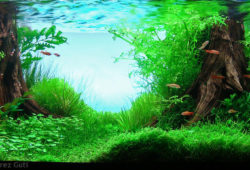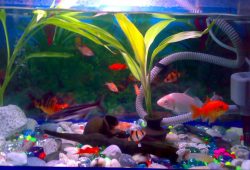Marine Pufferfishes from the Genus Arothron
The article gives you some information on Marine Pufferfishes from the Genus Arothron.

Contents
Fat Pufferfishes Make Excellent Tropical Saltwater Aquarium Fish
Pufferfishes belong to the family Tetraodontidae, and some make fantastic saltwater aquarium inhabitants. There are two subfamilies of pufferfishes: Canthigasterinae (the sharpnosed puffers and the tobies) and Tetraodontinae (the true puffers). While there are other pufferfishes appropriate, and even to be recommended, for the saltwater aquarium, it is the species in the genus Arothron that are best known and most readily available in North America.
Favorite Fat Pufferfish
There are nearly 20 described species of pufferfishes in the genus Arothron, and, collectively, they are commonly called “fat puffers.” Some of the more popular fat puffers are the dogface puffer (A. nigropunctatus), the guineafowl puffer (A. meleagris), the stars ‘n stripes puffer (A. hispidus) and the starry puffer (A. stellatus). All possess the characteristic large, blinking eyes and personable dispositions that make these fishes so popular.
True to their common name, all pufferfishes from the genus Arothron have the ability to “puff up” by taking up water (or air) and increasing their overall size by two to three times.
Hardy and Long-Lived Aquarium Fishes
In addition to having a splendid disposition, often acting like a puppy begging for food when their owner enters the room, fat puffers are remarkably hardy and long-lived. Once properly acclimated, most pufferfishes from the genus Arothron will pose few problems so long as the proper environment and husbandry protocols are maintained. Life expectancy is reported to be ten years or more in some cases.
The Pufferfish Aquarium
In terms of the proper environment for a fat puffer, an appropriately-sized, fish-only aquarium with plenty of live rock and swimming space is best. The pufferfish-ready aquarium should also employ robust filtration, preferably in the form of comprehensive sump-based filtration. An over-sized protein skimmer and well maintained mechanical filtration will help deal with the messy-eating habits of most puffers.
Best Tankmates for Pufferfishes
Most aquarists keep puffers in an aggressive tank with other aggressive or semi-aggressive fishes. Most invertebrates, including corals, ornamental shrimp and even sponges, are incompatible with fat puffers, and, as such, fat puffers should not be introduced to a reef tank. Triggerfishes, tangs, large angelfishes, and lionfishes all make excellent tankmates for pufferfishes.
Feeding a Pufferfish
Fat puffers will appreciate a diverse diet of fresh and commercially prepared foods offered twice a day. Mollusks, fed in their shell, will help the puffer wear down its teeth, although it may be necessary to manually file down the teeth of larger puffers. The aquarist should be careful when hand-feeding a large pufferfish, as the fish is capable of a nasty, albeit inadvertent, bite.
Handling a Pufferfish
“It is important to expose a pufferfish to air as little as possible,” says Mark Martin, director of marine ornamental research at Blue Zoo Aquatics and author of The Complete Idiot’s Guide to Saltwater Aquariums (Alpha 2009). “If they suck in air they have a hard time expelling it, and this can cause serious, even fatal, health issues.” In addition, Martin cautions against ever making a pufferfish inflate. “This is usually a fear response,” he says. “While the behavior is interesting, it can be stressful for the animal, and, in some cases, may lead to health issues.”



